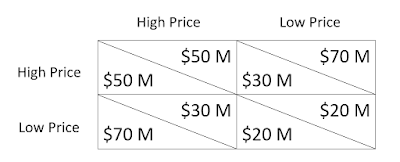Discuss whether an oligopolistic firm should collude rather than compete. [15 marks]

The given question is question 2.(b) from the November 2018 Economics Paper 1. N18/3/ECONO/HP1/ENG/TZ0/XX . For Question 2. (a), click here . As mentioned in the answer for 2. (a) , oligopolistic firms that collude benefit from higher profits and are more likely to continually earn abnormal profits in the long run too. Collusion grants firms many of the advantages that monopolies gain from as all firms act as one party. Firstly, with higher profits, they can invest in R&D to produce better/ greener technology and increase efficiency of production. This will not only reduce negative externalities in the long run but also increase the firms’ economies of scale. As big firms, oligopolies can benefit from various economies, for instance, managerial (as they hire better managers), purchasing (as they get discounts on bulk buying), financial (lower interest on loans), etc. However, the higher price for products mean that consumers cannot enjoy the benefits of lower costs....
